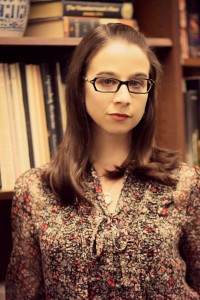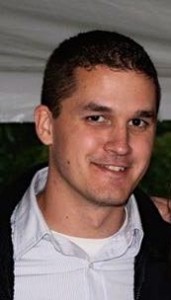 Christine Lasek’s “Precious Blood” is, on one level, a short story about a grandfather purchasing a pickup truck in which a man committed suicide. But the story, which appeared in the 2014 issue of the Sierra Nevada Review, is also about memory, war, loss and the bonds of family.
Christine Lasek’s “Precious Blood” is, on one level, a short story about a grandfather purchasing a pickup truck in which a man committed suicide. But the story, which appeared in the 2014 issue of the Sierra Nevada Review, is also about memory, war, loss and the bonds of family.
Lasek’s debut collection, Love Letters to Michigan, will be published in April 2016 by ELJ Publications. She holds an MFA in fiction from the University of South Florida, where she served as the managing editor of Saw Palm: Florida Literature and Art. She currently teaches creative and technical writing as a visiting instructor at USF and serves as the assistant to the creative writing program director.
Lasek is originally from Troy, Michigan, and graduated from the University of Michigan—Ann Arbor in 2003. Prior to pursuing a degree in creative writing, she worked as a web editor and public relations official for companies in and around Detroit.
Lasek’s fiction and nonfiction have been published in Coal City Review, Tampa Review Online, and VIA: Voices in Italian Americana, among others.
**
Brandon Dudley: What was the initial spark for “Precious Blood”?
Christine Lasek: That’s an easy one. A friend and I were discussing Joan Wickersham’s The Suicide Index, a book I was reading as part of a Craft of Nonfiction class. In the middle of the conversation, my friend said, “You know, my grandfather once bought a truck some dude killed himself in. He got it cheap because he had to clean it out himself.” What WHAT?! And the seed of the story was planted.
BD: Wow. I often wonder about parts of stories, whether they’re based in reality or not, if they’re something that the author really experienced. I can safely say that part of your story was not on my radar, though.
Is that a common way that stories start for you? Is the seed usually some real life event that you just run with? Or is it more often something else, like an image or a specific line of the story that comes to you first?
CL: It depends on the piece. Sometimes it’s an image, sometimes more. For me, though, it always has to do with people—how they interact, how they hurt or love each other, how we make sense of it. I find myself most inspired when I have the chance to meet new people—while I’m getting to know them, my brain is busy creating their back story. Characters in my work often come from that.
BD: I’m curious about the non-linear structure of your piece. Why do you think that was the best way to tell this particular story?
CL: I didn’t start out with that intention. This story started out as Eric’s story—his section (the first) was in first person, while the other sections were written in third. I wanted to give the reader his thoughts/impressions, then show what led up to the exchange between Eric and his mother in the first section.
But when the piece went through workshop, my classmates felt the story would be better told if all sections were written in third person, in order to illustrate the differences between the three characters. Once I rewrote the first part, I agreed–that change made the piece stronger. So that’s how it came to be in its current form.
BD: I’ve played around with stories that have used a mix of first and third person before, and so far they’ve never quite worked either. What do you think a story needs to make that work, to make that point of view switch necessary?
CL: With POV (and really any style decision you make in a piece), the style element needs to further the theme of the story. As a fiction writer, when I put pen to paper, it’s more than just telling an interesting story. I am trying to tell the reader SOMETHING–about what makes us human, about how we relate to each other. This “something” is the story’s theme. All of the choices I make in a story need to further that theme, that reason for why the story exists. When it comes to jumping POVs, the jumps not only have to further the “something,” but their benefits to the story have to outweigh the potential drawbacks (namely, confusing the reader and/or stunting the reader’s ability to form a meaningful connection with a character over time).
BD: How do you think teaching has affected your writing?
CL: This is a giant question. Let’s just say, as a teacher, I give good advice on writing, and then when I revise my own work, I find that I don’t always follow my own good advice. But the more I teach, the less this happens. Thank you, students.
BD: I saw you have a collection coming out in the spring. Could you tell me a little about that?
CL: My collection is called Love Letters to Michigan and all of the stories take place in my home state. I didn’t set out to write a series of Michigan-set stories, but when I moved to Florida for my MFA, crisp fall days and blue, blue skies started pervading my work.
The collection is due out in April by ELJ Publications and I couldn’t be more ecstatic!
BD: Besides the location, are there any themes that link the stories in the collection? Are there any themes in general that you feel like you come back to frequently in your work?
CL: The stories in my collection are only linked by place. The main characters are all ages, both male and female.
But two subjects that I explore again and again in my work include family relationships and “stuff”–the stuff that we own and what it says about us. I also write a lot of characters who are (or have) single mothers, but I’m not sure why that subject comes up again and again.
BD: Who do you consider influences on your work?
CL: My writing hero is Alice Munro. The way she creates character, her use of setting, of dialogue–a whole world in a short story, and not just once, but over and over again. I want my stories to feel like that. The first collection of hers I read was Something I’ve Been Meaning to Tell You, and I have been hooked ever since.
BD: Where do you see your writing going next? What’s your next writing project?
CL: I am up to my neck in editing the book, but doing revisions always makes me itchy to start something new. Right now, it looks like the next project will be a second collection of short stories.
 Brandon Dudley is a fiction candidate in the MFA program at Sierra Nevada College, where he is assistant fiction editor of the Sierra Nevada Review. His fiction has been a finalist in the Slice Literary Writers Conference Bridging the Gap Competition and a Million Writers Award nominee. He has had interviews and criticism published in storySouth and Fiction Advocate. He lives in Maine with his wife and two sons.
Brandon Dudley is a fiction candidate in the MFA program at Sierra Nevada College, where he is assistant fiction editor of the Sierra Nevada Review. His fiction has been a finalist in the Slice Literary Writers Conference Bridging the Gap Competition and a Million Writers Award nominee. He has had interviews and criticism published in storySouth and Fiction Advocate. He lives in Maine with his wife and two sons.
